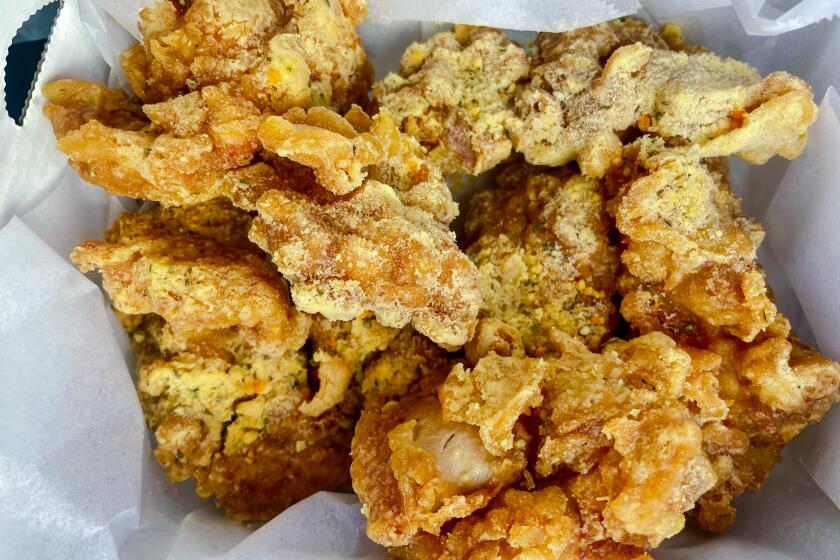Master Class: Tom Colicchio on thinking outside the vinaigrette box
Chef Colicchio’s advice: Be adventurous in flavor combinations and use it to marinate or braise meat or fish.
» Thinking outside the vinaigrette box
Chef Colicchio's advice: Be adventurous in flavor combinations and use it to marinate or braise meat or fish.
In my many years as a professional chef and an occasional dinner party guest, I've been on the receiving end of my fair share of spontaneous, frustrated confessions from home cooks feeling insecure about their repertoire of dishes. Some vent that they are short on time, others that their kitchens are tiny, they can't spend a fortune on ingredients, they have limited access to some of the fancy equipment that we pros take for granted.
These stumbling blocks are perfectly understandable. But to my mind, one of the biggest constraints on culinary creativity doesn't require time, space or money to overcome. It's the simple force of convention: the ways in which we're conditioned to eat certain ingredients in specific combinations and contexts.
Convention is the reason why most home cooks see eggs as primarily a breakfast food, rhubarb as a dessert ingredient and olive oil as a savory one. Breaking down those barriers opens up worlds of possibility. It gives rise to things like farm egg and asparagus salad, rhubarb chutney and olive oil ice cream.
Consider the vinaigrette, which I rate as the most under-appreciated sauce in existence. It is a sauce, after all, and relegating it to cold salads ignores its vast potential with fish and meat, where it can work as a marinade, as a braising medium and as a finishing sauce. Likewise, limiting yourself to the same old combination of red wine vinegar and olive oil misses out on the huge range of flavors achievable in a vinaigrette.
Let's start with the basics. A vinaigrette is a mixture of acid, liquid fat and seasonings. Most herbs and spices are fat-soluble, which means their flavors really bloom in the presence of oil. Fat also provides the body necessary to help a sauce cling to the surface of foods. The function of the vinegar, in addition to dissolving aromatic compounds found in herbs and spices, is to brighten up a dish, adding a tangy counterpoint to earthy, rich or spicy flavors.
A traditional vinaigrette is a temporary emulsion — a finicky mixture of one liquid dispersed in another (in this case, oil in vinegar). The challenge with an emulsion is to combine two liquids that do not dissolve in each other. One way to do this is mechanically: use the force of a whisk or, better yet, a blender, to physically break the oil into millions of individual droplets.
Emulsifiers, such as the proteins found in milk or egg yolks, help lower the surface tension of the oil and make it easier to break apart. Stabilizers, like mustard, tomato paste, egg white or roasted garlic, help emulsified liquids stay evenly combined. Vinaigrettes tend to be unstable emulsions because of the high proportion of oil to vinegar, so they separate out ("break," in kitchen parlance) easily. Forgoing emulsifiers and stabilizers, adding in the oil all in one go or getting the vinaigrette very hot or cold will likely result in a broken emulsion.
Luckily, unlike a mayonnaise or hollandaise sauce that needs to stay emulsified to be useable, vinaigrettes are perfectly acceptable either emulsified or broken, regardless of whether they're being used as a dressing or marinade or braising medium. Often in the case of salad dressings, the oil and vinegar aren't even emulsified to begin with; they're just drizzled over separately. It's simply a matter of preference.
When making a vinaigrette, three parts oil to one part vinegar is a good starting point, but this will need to be adjusted based on how pungent your acid is, as well as your personal preferences. Start by whisking together the acid, added flavorings and the emulsifier/stabilizer, if you're using one. Add the oil in a constant stream, whisking continuously, so that a smooth sauce begins to form. You can follow the same process with a blender. Taste it, and adjust the amount of oil accordingly.
Once you have this technique down, the possible combinations are almost endless:
• Acids: Vinegars (red, white, balsamic, sherry, rice, malted barley, Champagne, apple cider), citrus juices, verjus. These differ not only in flavor but also in acidity level. Rice vinegar is one of the mildest acids, and wine vinegars among the strongest, with lemon juice somewhere in the middle. Vinegars will state their acidity level (a percentage, usually between 4% and 7%) on the bottle, but you can also just use your sense of taste as a judge and adjust oil usage accordingly.
• Fats: Canola oil, olive oil, nut oils (peanut, walnut, hazelnut), bacon fat, heavy cream, crème fraîche. Peanut oil and canola oil are neutral in flavor and aroma, whereas nut oils and certain olive oils can be overpowering if used in large quantities. Keep in mind that animal fats, like bacon fat, are solid at room temperature.
• Emulsifiers/stabilizers: Mustard, egg yolks, roasted garlic, fruit and vegetable purees, stocks. These often impart flavor, but their primary function is to help in mounting the oil into the acid and/or keeping the vinaigrette in suspension.
• Flavorings: Shallots, leafy herbs, fresh and dried spices. Their sole function is to add specific flavors and aromas to the vinaigrette. Especially in an oil-heavy vinaigrette, leafy herbs will tend to discolor over time.
Consider using a vinaigrette as a punchy sauce to transform meat or fish, adding a brightness to complement roasted or grilled flavors. Vinaigrette is a refreshing alternative to richer butter- and stock-based sauces. Chimichurri, an herb vinaigrette that's commonly served with grilled steak in South America, is the most common example of a vinaigrette used as a sauce for meat.
Vinaigrettes also make exceptional marinades, with the oil basting the surface of the meat while the vinegar flavors it and increases its ability to retain moisture. This technique works especially well with small pieces of meat, as marinades don't penetrate deeply and will only work close to the surface of the protein.
Fish should be marinated in vinaigrette for no more than 30 minutes, and meats can stay in the marinade for up to several hours. The more acidic the marinade and delicate the protein, the shorter the marinating time, because over time strong acids will begin to change the texture of the meat (for the worse).
Vinaigrette can also be used as a braising medium for seafood, infusing the flesh deeply with flavor while keeping it moist. When most people think of braising they think of cooking meat low and slow in the oven, but the technique really just refers to searing an ingredient and then cooking it gently in liquid, either in the oven or on the stovetop. It's advisable to use vinaigrettes only for quick braises (less than 10 minutes), otherwise the vinegar will begin to flavor the protein too pungently.
The recipe for braised sea bass illustrates the technique behind a quick stovetop braise. Any skin-on fish can be substituted, and any vinaigrette. Just keep in mind that the heat will break the vinaigrette, so avoid using cream, chunky purees or anything else that will look unappetizing when broken.
Eat your way across L.A.
Get our weekly Tasting Notes newsletter for reviews, news and more.
You may occasionally receive promotional content from the Los Angeles Times.










